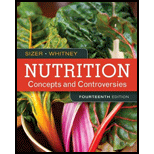
Nutrition: Concepts and Controversies - Standalone book (MindTap Course List)
14th Edition
ISBN: 9781305627994
Author: Frances Sizer, Ellie Whitney
Publisher: Brooks Cole
expand_more
expand_more
format_list_bulleted
Question
Chapter 3, Problem 18SC
Summary Introduction
Introduction:
Alcoholic beverage is a drink which contains ethanol. It has several effects on human body. The effects depend on the concentration of the drink and the amount of drink consumed. Some amount of alcohol is absorbed by the body while drinking and proper process of absorption starts after drinking alcohol.
Expert Solution & Answer
Trending nowThis is a popular solution!

Chapter 3 Solutions
Nutrition: Concepts and Controversies - Standalone book (MindTap Course List)
Ch. 3 - Moderate alcohol use has been credited with...Ch. 3 - Your daughter is leaving for college in the fall....Ch. 3 - Cells a. are self-contained, living units. b....Ch. 3 - Each gene is a blueprint that directs the...Ch. 3 - Prob. 3SCCh. 3 - Prob. 4SCCh. 3 - Hormones a. are rarely involved in disease...Ch. 3 - Prob. 6SCCh. 3 - Prob. 7SCCh. 3 - Prob. 8SC
Knowledge Booster
Similar questions
- Your daughter is leaving for college in the fall. Recently, there has been disturbing news about the excessive drinking on college campuses and even a report about the death of one student who had been drinking excessively at the college your daughter is planning to attend. Form a group of four or five people. Each group has an imaginary daughter who is leaving for college. Each member of the group will choose one of the topics listed below' and prepare a short (one-minute) speech that attempts to educate your daughter on the dangers of excessive drinking. To facilitate the speakers delivery, a group member takes on the role of "daughter," rotating the role with each speaker. Be sure to emphasize facts as much as possible with your argument. Explain the physiology of the hangover, including dehydration, formaldehyde, and methanol. Discuss the role of alcohol in weight gain. Describe alcohols effect on vitamins. Describe the effect of alcohol on the heart and brain. Describe alcohol's effect on the liver and other organs.arrow_forwardModerate alcohol use has been credited with providing possible health benefits. Construct an argument for why moderate alcohol use to provide protection from heart disease or other health problems may not be a good idea.arrow_forwardRegarding fluid intake in school-age children, which of the following statements is most correct? a. Soft drinks are good choices for hydration during exercise because the high carbohydrate content provides quick energy. b. Childrens caffeine consumption decreases as they get older. c. Diluted fruit juice is a good choice for hydration during exercise, as children are more likely to drink it than water. d. Adults who are supervising children during exercise can rely on the children to let them know when they are thirsty.arrow_forward
Recommended textbooks for you
- Essentials of Pharmacology for Health ProfessionsNursingISBN:9781305441620Author:WOODROWPublisher:CengageLifetime Physical Fitness & WellnessHealth & NutritionISBN:9781337677509Author:HOEGERPublisher:Cengage
 Understanding Nutrition (MindTap Course List)Health & NutritionISBN:9781337392693Author:Eleanor Noss Whitney, Sharon Rady RolfesPublisher:Cengage Learning
Understanding Nutrition (MindTap Course List)Health & NutritionISBN:9781337392693Author:Eleanor Noss Whitney, Sharon Rady RolfesPublisher:Cengage Learning Comprehensive Medical Assisting: Administrative a...NursingISBN:9781305964792Author:Wilburta Q. Lindh, Carol D. Tamparo, Barbara M. Dahl, Julie Morris, Cindy CorreaPublisher:Cengage Learning
Comprehensive Medical Assisting: Administrative a...NursingISBN:9781305964792Author:Wilburta Q. Lindh, Carol D. Tamparo, Barbara M. Dahl, Julie Morris, Cindy CorreaPublisher:Cengage Learning

Essentials of Pharmacology for Health Professions
Nursing
ISBN:9781305441620
Author:WOODROW
Publisher:Cengage


Lifetime Physical Fitness & Wellness
Health & Nutrition
ISBN:9781337677509
Author:HOEGER
Publisher:Cengage


Understanding Nutrition (MindTap Course List)
Health & Nutrition
ISBN:9781337392693
Author:Eleanor Noss Whitney, Sharon Rady Rolfes
Publisher:Cengage Learning

Comprehensive Medical Assisting: Administrative a...
Nursing
ISBN:9781305964792
Author:Wilburta Q. Lindh, Carol D. Tamparo, Barbara M. Dahl, Julie Morris, Cindy Correa
Publisher:Cengage Learning